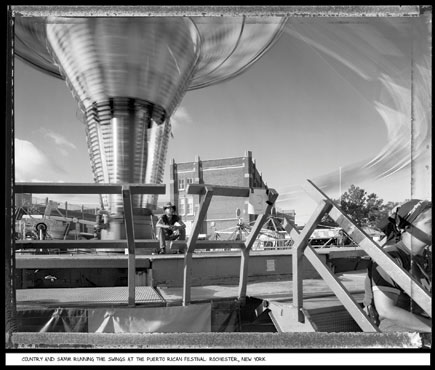Black And White: Digital And Silver Combined; An Interview With Eric Luden Page 2
EL: Archival is often misused as a definition. If you mean an image’s ability to be around for 100 years, the answer is yes. According to Henry Wilhelm, the fiber-based black-and-white print, when reasonably well processed and washed—and especially if it’s selenium toned—can be considered the high-water mark of photography in terms of permanence. At Digital Silver Imaging we use traditional photo paper and chemistry. Our fiber baryta paper is proven to withstand the test of time. Giclee, LightJet, inkjet, and other prints have only been around for a very short time and their longevity is not known.
Birds Nest |
|
 |
|
|
SB: Can you make a true black-and-white print with no tone to it?
EL: Most definitely. Our paper is true silver gelatin black and white. The paper is exposed to light with a tricolor photographic laser and then processed in traditional Ilford black-and-white photo chemicals. Unlike many other processes there is no color involved, so our prints are completely neutral. By using traditional chemical toning methods, like sepia or selenium, we can produce traditional black-and-white tones with added archival benefits.
SB: Is there a preferred method of converting color images to black and white in Photoshop?
EL: Any method that preserves the RGB layers is best because you retain the most amount of information in the file. There are myriad methods to achieve this, but one has to avoid overdoing it in Photoshop. The biggest mistake to be made is adjusting one of the color sliders too much and essentially discarding valuable information for the printer to render a specific tone or detail. We advise our clients to maintain the native resolution of their file when uploading to Digital Silver Imaging to avoid an unnecessary artifacting.
Country and Samm Running the Swings at the Puerto Rican Festival: Rochester, NY |
|
 |
|
|
SB: Do you have software recommendations other than Photoshop?
EL: Lightroom and Aperture work equally as well. We especially like Nik Silver Efex Pro as a plug-in to Photoshop, Lightroom, and Aperture. Silver Efex Pro is just like working in a darkroom, it’s very intuitive and the control it gives you is amazing. Working with Nik allows us and the photographer to ensure proper files for optimal printing.
SB: Can you tell me about current papers for printing in black and white?
EL: Ilford currently produces two silver gelatin papers. Ilford Galerie FB Digital is identical to the Ilfobrom Galerie double-weight fiber paper they have made for years. It has a neutral image tone and a semigloss finish when air-dried. Ilfospeed Pearl RC Digital is also identical to their traditional resin-coated darkroom papers, like Multigrade RC. Both of these products are only sold in rolls intended for commercial lab use.
SB: Is it possible to get a true black-and-white image using a color process like RA-4?
EL: I would argue that this is not possible at all. By the very nature of the “color” RA-4 process, you are trying to replicate a pure black-and-white process utilizing unstable color dyes. The most common complaint is the magenta or cyan color cast seen on black-and-white prints from color labs.
SB: Describe what you believe is the path to optimum print quality.
EL: For today’s digital shooter, we recommend shooting in Raw to capture the greatest detail and information. The file should be adjusted in Adobe Camera Raw for exposure and any other compensation prior to being imported into Photoshop or other image-editing software. We open the file as a Smart Object in Photoshop to allow us to go back and edit any of the Nik filters we utilize. We have found that the Nik Silver Efex Pro software does a phenomenal job of converting a color RGB file to black-and-white RGB with all channels remaining neutral. We work with the files in Silver Efex Pro by using the film grain engine and control points to recreate a very realistic black-and-white file. By printing on silver paper and fixing in traditional chemistry, we produce a darkroom-quality print from a digital file. It is exciting to be on this forefront of technology enhancing traditional photography.
For more information, visit: www.digitalsilverimaging.com.
- Log in or register to post comments

















































